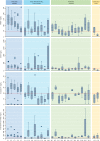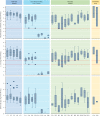Microbial and chemical contamination of water, sediment and soil in the Nakivubo wetland area in Kampala, Uganda
- PMID: 26122126
- PMCID: PMC4486093
- DOI: 10.1007/s10661-015-4689-x
Microbial and chemical contamination of water, sediment and soil in the Nakivubo wetland area in Kampala, Uganda
Abstract
The reuse of domestic and industrial wastewater in urban settings of the developing world may harm the health of people through direct contact or via contaminated urban agricultural products and drinking water. We assessed chemical and microbial pollutants in 23 sentinel sites along the wastewater and faecal sludge management and reuse chain of Kampala, Uganda. Water samples were examined for bacteria (thermotolerant coliforms (TTCs), Escherichia coli and Salmonella spp.) and helminth eggs. Physico-chemical parameters were determined. Water, sediment and soil samples and edible plants (yams and sugar cane) were tested for heavy metals. Water samples derived from the Nakivubo wetland showed mean concentrations of TTCs of 2.9 × 10(5) colony-forming units (CFU)/100 mL. Mean E. coli was 9.9 × 10(4) CFU/100 mL. Hookworm eggs were found in 13.5% of the water samples. Mean concentrations of iron (Fe), copper (Cu) and cadmium (Cd) were 21.5, 3.3 and 0.14 mg/L, respectively. In soil samples, we found a mean lead (Pb) concentration of 132.7 mg/L. In yams, concentrations of Cd, chromium (Cr) and Pb were 4.4, 4.0 and 0.2 mg/L, while the respective concentrations in sugar cane were 8.4, 4.3 and 0.2 mg/L. TTCs and E. coli in the water, Pb in soil, and Cd, Cr and Pb in the plants were above national thresholds. We conclude that there is considerable environmental pollution in the Nakivubo wetland and the Lake Victoria ecosystem in Kampala. Our findings have important public health implications, and we suggest that a system of sentinel surveillance is being implemented that, in turn, can guide adequate responses.
Figures



References
-
- Abaidoo RC, Keraita B, Drechsel P, Dissanayake P, Maxwell AS. Soil and crop contamination through wastewater irrigation and options for risk reduction in developing countries. In: Dion P, editor. Soil biology and agriculture in the tropics, soil biology. Berlin: Springer-Verlag; 2010. pp. 275–297.
-
- Ackah M, Anim AK, Gyamfi ET, Zakaria N, Hanson J, Tulasi D, Enti-Brown S, Saah-Nyarko E, Bentil NO, Osei J. Uptake of heavy metals by some edible vegetables irrigated using wastewater: a preliminary study in Accra, Ghana. Environmental Monitoring and Assessment. 2013;186:621–634. doi: 10.1007/s10661-013-3403-0. - DOI - PubMed
-
- APHA, AWWA, & WEF . Standard methods for the examination of water and wastewater. 21. Washington: American Public Health Association, American Water Works Association, Water Environment Federation; 2005. pp. 1–564.
-
- Ayres RM, Mara DD. Analysis of wastewater for use in agriculture: a laboratory manual of parasitological and bacteriological techniques. Geneva: World Health Organization; 1996. pp. 1–35.
-
- Barifaijo E, Musisi L, Muwanga AJN, Opuda-Asibo J. Heavy metal loading of wetlands around Lake Victoria in Uganda and its implications to antibiotic resistance in environmental E. coli. African Journal of Science and Technology. 2009;10:64–78.
Publication types
MeSH terms
Substances
LinkOut - more resources
Full Text Sources
Other Literature Sources
Miscellaneous

